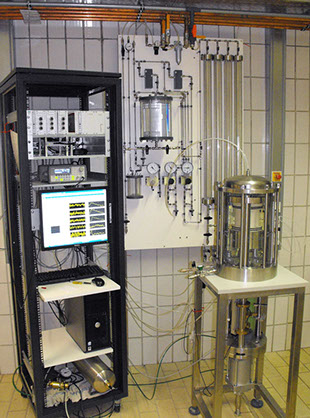Material Behaviour

Based on laboratory tests, the mechanical properties of the relevant soil layers must be determined in order to execute the required proofs of safety for foundation structures.
Standard Laboratory Tests
The IBF provides all standard lab tests common in soil and rock mechanics, moreover a large choice of special soil mechanical testing devices (ring shear box, direct shear and tensile test, biaxial test large oedometer up to 500 mm, large triaxial cell up to 800 mm, resonant column test up to 1000 mm, freezing laboratory, permeability of bulk and sealing materials up to 1200 mm, suction measuring). For the investigation of rock samples the largest test equipment within Germany is offered (high pressure triaxial testing, large triaxial tests up to 600 mm, direct shear, creep, relaxation and swelling tests). These tests are necessary for the determination of limit strength quantities for continua and discontinua in dependence of stress state, density, water content and chemism respectively for the determination of constitutive parameters.
Cyclical Triaxial Testing
Wind power plants are characterized by their high cyclic loading portion with large cycle numbers. Proofs of serviceability state are determined by accumulated deformations during their lifetime. The cyclic laboratory at the IBF hosts strain- and stress-controlled cyclic triaxial cells for different pressure ranges with extremely high accuracy. By means of them, cyclic material parameters can be determined which are required as input for cyclic constitutive laws. Special load paths typical for wind power plants can be realized. Cyclic tests are also used for an evaluation of the cyclic liquefaction resistance. Based on these tests, the designer has to assess whether pore water overpressures may be generated below a foundation which could endanger the wind turbine’s stability.
- “Development of a user-friendly design and monitoring concept for offshore foundations under cyclic loading“ (BMU 0327618, 2006-2011)
- “Validation of a design concept for gravity foundations of offshore wind energy converters under high-cycle loads using monitoring data of a full-scale field test“ (BMU/BMWi 0325405, 2012-2015)
- “KonTest – Conceptual design of a wind energy test field in mountainous complex terrain“ (BMU/BMWi 0325656C, 2013-2015)
- “TremAc – Objective criteria for seismic and acoustic emissions of inland wind energy converters”, subproject “Wave propagation and dynamic soil-structure-interaction“ (BMWi 0325839A, proposal soon to be accepted, from 2015)
- “System dynamics and long-term performance of railway undercarriage, track and substructure“, subproject “Compliance of the ballast superstructure” (DFG-SPP 1015, 1996-2002)
- “Strong earthquakes: From the basics of geosciences to engineering measures“, subproject “Nonlinear wave phenomena in fine-grained and compressive soils“ (DFG-SFB 461, 1996-2007)
- “Influence of changes in the subsoil fabric on the endurance of structures“, subproject “Loss of equilibrium in saturated and dry granular skeletons“ (DFG-SFB 398, 1999-2007)
- “Development of methods for ultimate limit and serviceability limit state design of ductile geotechnical structures subject to strong earthquakes“ (DFG, 2003-2010)
- “Evolution and implication of boundary layers on walls and columns in granular soil“ (DFG, 2003-2008)
- “Innotrack – Innovative Track Systems”, subproject “Track Support Structure“ (EU, 2006 – 2010)
- “GeoTech – Modelling geotechnical construction processes with holistic aquisition of the stress-strain-behaviour of soils“, subproject „Soil deformations on retaining walls due to vibrations“, “Neo-Hypoplasticity“ und „Central project including an experimental demonstrator“ (DFG-FOR 1136, since 2009)

